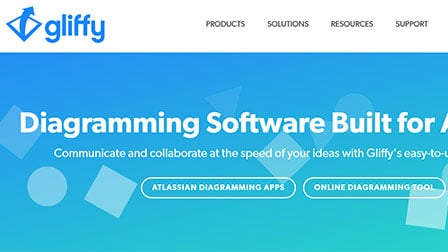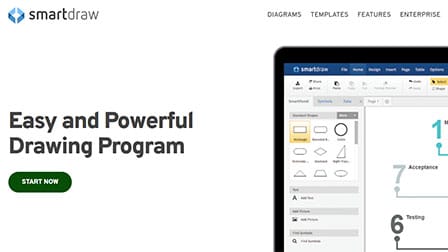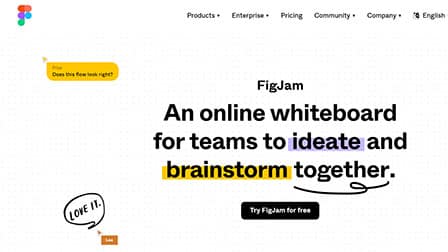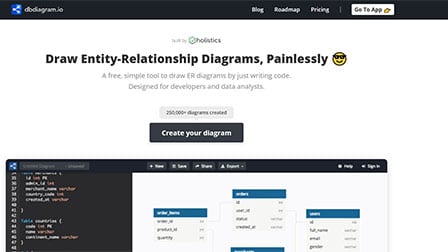In today’s data-driven world, designing robust and efficient databases is critical for the success of applications, websites, and software systems. Whether you’re a database architect, developer, data analyst, or student, having the right tool to visually plan and organize your data structure can make all the difference. That’s where Entity Relationship Diagrams (ERDs) come into play — and choosing the best ER diagram tool in 2025 can streamline your workflow like never before.

So, what exactly is an ER diagram?
An Entity Relationship Diagram (ERD) is a type of flowchart that illustrates how entities such as people, objects, or concepts relate to one another within a database system. ERDs use standardized symbols like rectangles (entities), diamonds (relationships), and ovals (attributes) to map out a system’s data architecture clearly and logically. These diagrams help identify the structure of the database, define primary and foreign keys, and make communication between stakeholders more effective.
Whether you’re modeling a simple database or designing a complex relational system, ER diagrams offer a visual foundation for understanding and refining data structures before actual implementation.
With the rise of cloud platforms, AI integrations, and collaborative development in 2025, ER diagramming tools have evolved to offer real-time collaboration, intuitive drag-and-drop interfaces, and seamless database integration. In this guide, we’ll walk you through the best ER diagram tools for 2025—from beginner-friendly platforms to advanced solutions trusted by data professionals across the globe.
Let’s explore the top tools to help you create clean, accurate, and insightful ER diagrams for your next project.
1. Visme: A Powerful and Intuitive ER Diagram Tool for 2025

When it comes to building and visualizing complex data relationships, Visme stands out as a powerful and user-friendly ER diagram maker.
Designed to simplify database modeling, Visme provides an intuitive workspace, pre-designed templates, and collaborative features, making it a top choice for data analysts, developers, and educators alike in 2025.
With Visme’s ER Diagram Tool, users can effortlessly model how entities—like users, products, or processes—interact within a system. Whether you’re documenting an existing database or planning a new structure from scratch, Visme helps you create clear, professional-looking ER diagrams in just a few clicks. The platform offers a library of customizable templates, each tailored for different industries and project types. Users can easily tweak these templates to reflect their exact data model by modifying entity names, attributes, relationships, and connectors.
One of Visme’s strongest features is its drag-and-drop editor, which allows you to add, move, and customize entities without needing advanced technical knowledge. Fonts, colors, layout, and line styles are fully editable—giving your ER diagrams a polished, presentation-ready appearance. The visual clarity Visme offers ensures that even complex database structures are easily understood.
For collaborative projects, Visme truly shines. You can invite team members to co-edit the ER diagram in real time, making it a great tool for cross-functional teams. Contributors can leave comments, suggest edits, and make live changes—all within the same interface. Once finalized, diagrams can be exported in formats such as PNG, JPG, PDF, or HTML, or shared directly online through a secure link for instant feedback and approvals.
The platform is ideal for both beginners and professionals. New users benefit from Visme’s pre-defined shapes and user-friendly interface, while seasoned database designers appreciate the flexibility to structure and document intricate relationships. The ability to embed interactive elements also allows you to create more dynamic and informative diagrams when presenting to stakeholders.
Overall, Visme is much more than a basic ER diagram maker—it’s a full-fledged visual communication platform that brings clarity and precision to database modeling.
Pros:
- Easy-to-use, drag-and-drop interface
- Real-time team collaboration and commenting
- Professionally designed, customizable templates
- Multiple export options (PNG, JPG, PDF, HTML)
- Interactive elements and presentation-ready visuals
Cons:
- Some advanced features require a paid upgrade
- Not a dedicated database tool (lacks code generation)
Visme offers a modern, versatile solution for anyone looking to create accurate and visually compelling ER diagrams in 2025.
2. Edraw Max Online – Best for Versatility

Edraw Max is known for its versatility. You can create a wide range of diagrams, including ERDs, with ease.
This tool offers a wide variety of professionally designed templates, ensuring that even beginners can create professional-grade diagrams in no time.
Pros:
- Highly versatile with multiple types of diagrams.
- Professionally designed templates available.
- Exports diagrams in various formats.
Cons:
- No real-time backup feature.
Best for: Beginners or users who prefer an easy and straightforward interface.
Price: Free trial available, premium plans required for advanced features.
3. Creately – Best for Clean Design

Creately offers an intuitive and clean interface for designing ERDs. With drag-and-drop functionality and a contextual toolbar, Creately makes diagramming easy and efficient.
It also supports real-time collaboration, making it a good choice for teams.
Pros:
- Drag-and-drop design for fast creation.
- Real-time collaboration with team members.
- Customization options for colors, fonts, and shapes.
Cons:
- Limited customer support.
Best for: Users who value simplicity and clean design.
Price: Free with limited features, paid plans for more tools.
4. Miro – Best for Interactive Features

Miro is a highly interactive platform known for its visual collaboration tools. It allows users to create ERDs quickly using pre-designed templates, making it ideal for teams that need to brainstorm or work together on database projects.
Pros:
- Wide range of templates for various diagram types.
- Advanced team collaboration and commenting features.
- Customization options with a variety of shapes and colors.
Cons:
- Issues with drag-and-drop functionality on certain devices.
Best for: Interactive teams needing robust collaboration tools.
Price: Free with basic features, premium available.
5. Canva – Best for Beginners

If you’re new to ERDs and prefer a tool with pre-made templates, Canva is a fantastic option.
Canva’s user-friendly interface and vast template library make it easy to create ERDs without any prior technical knowledge.
Pros:
- User-friendly interface with drag-and-drop features.
- Wide range of professionally designed templates.
- Free to use with a large number of features.
Cons:
- Mostly template-driven with limited manual design options.
Best for: Beginners and those who prefer visual templates over manual design.
Price: Free, with premium options for additional features.
6. Visual Paradigm – Best for Customization

Visual Paradigm is a powerful and flexible tool for those who need more advanced customization options.
It features an ad-free interface and offers unlimited diagram creation, making it a popular choice for serious database designers.
Pros:
- No ads or interruptions.
- Full customization of ER diagrams with drag-and-drop ease.
- Cross-platform support for teams.
Cons:
- The premium version can be expensive.
Best for: Advanced users who need detailed customization.
Price: Free version for individual users, paid plans for teams.
7. Gliffy – Best for Simplicity

Gliffy is one of the easiest tools to use for ERDs. It offers a clean interface with a drag-and-drop feature, allowing users to quickly create diagrams and collaborate with others.
It’s an ideal choice for people who need a quick solution without complicated features.
Pros:
- Instant collaboration and commenting on diagrams.
- Simplified drag-and-drop design interface.
- Access to previous versions of diagrams.
Cons:
- Limited color customization options.
Best for: Small teams or individuals looking for simplicity and speed.
Price: Free with basic features, premium plans available.
8. SmartDraw – Best for Automatic Diagram Generation

SmartDraw is an intelligent tool that can automatically generate ERDs based on existing data.
It offers a wide range of templates and customization options, making it one of the most powerful tools for diagramming.
Pros:
- Automatically generates diagrams from your data.
- Intelligent formatting for professional diagrams.
- Wide variety of templates and customization options.
Cons:
- Limited customization for shapes and objects.
Best for: Businesses or teams that need automation for large-scale projects.
Price: Free trial available, paid plans for advanced features.
9. FigJam – Best for Collaborative Mapping

FigJam is a highly interactive tool that excels at collaborative design. It allows users to create ERDs and map processes interactively with team members, making it a perfect choice for teams that focus on collaboration and planning.
Pros:
- Excellent for concept mapping and brainstorming.
- Interactive tools for real-time collaboration.
- Easy documentation for processes and pathways.
Cons:
- Limited image editing options.
Best for: Teams focusing on process mapping and collaboration.
Price: Free for basic use, paid options for advanced features.
10. Dbdiagram – Best for SQL Integration

If you’re working in the developer or analytics space, Dbdiagram is an excellent tool for creating ERDs through code.
The diagrams can be generated from SQL files, making it ideal for those who are comfortable with technical processes.
Pros:
- Automatically generate diagrams from SQL.
- Easy code-based diagram creation.
- Exportable in multiple formats.
Cons:
- The interface can be tricky for beginners.
Best for: Developers who need a coding-based tool with SQL support.
Price: Free with advanced paid features.
How to Choose the Right ERD Tool
When deciding on the best tool for your ERD needs, consider the following:
- Team Collaboration: If you’re working with others, tools like Lucidchart, Creately, or Miro are excellent.
- Beginner-Friendly: Tools like Canva and Gliffy offer easy-to-use templates and interfaces.
- Advanced Features: Visual Paradigm and SmartDraw are perfect for those who need customization or automatic generation from existing data.
- SQL Integration: Dbdiagram is the go-to for developers who want code-based ERD creation.
Conclusion
Entity Relationship Diagrams (ERDs) are essential for visualizing database structures, and the right tool can make all the difference. Whether you’re looking for something simple and template-driven like Canva, or something more advanced with SQL integration like Dbdiagram, there’s a tool on this list for you. Be sure to evaluate your needs – whether it’s real-time collaboration, customization, or ease of use – before making a decision.
With one of these tools in hand, you’ll be able to design, visualize, and share ERDs quickly and effectively, ensuring smooth communication and better project outcomes.
